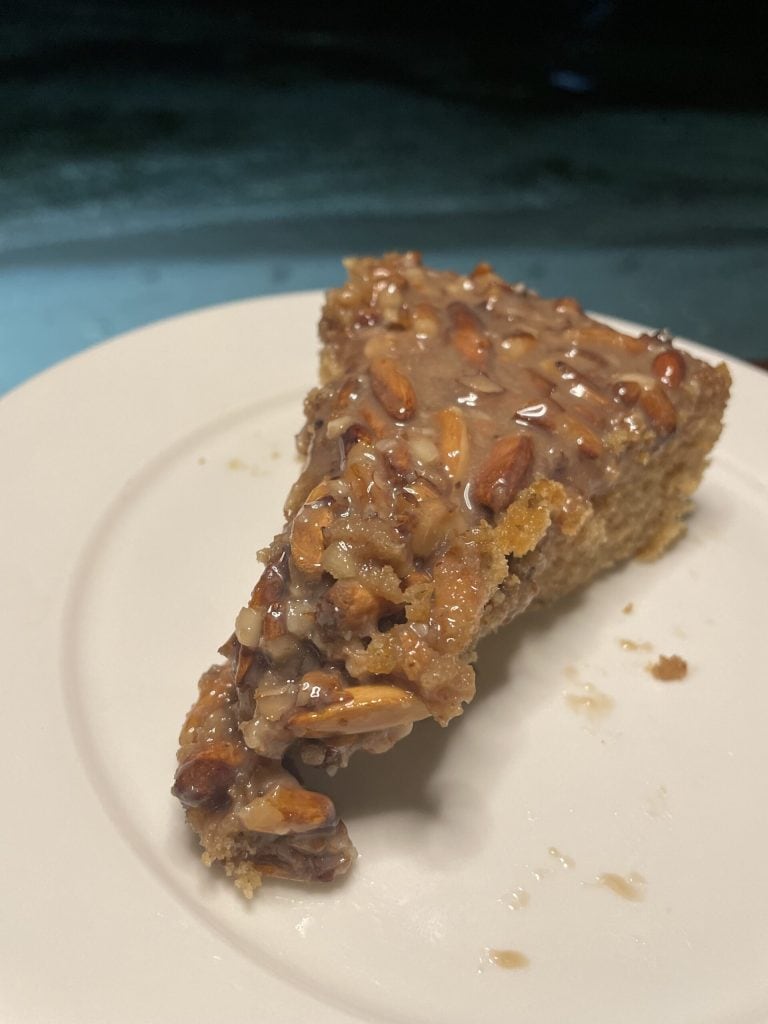The Kanamadhu Cake is a dessert often served during tea time or as a festive sweet in the Maldives.
The name “kanamadhu” (or “kanamadhu / kanamadu”) refers to the fruit/seed also known as sea almond (in English) or “sea almond”. This seed is used in the Maldives as a traditional sweet ingredient.
It is a dessert that combines a local ingredient (kanamadhu) with Western cake techniques (flour, eggs, sugar, oven). Thus, it represents a fusion between local tradition and modern pastry influence.
The main elements that make up the cake are:
• Kanamadhu: ground or pulverized and incorporated into the cake batter. This gives the dessert a typical flavor and texture.
• Wheat flour, baking powder, eggs, sugar, butter or oil, milk (In some recipes, sour cream or yogurt is used as a moistening agent).
• For the glaze or topping: butter, brown sugar, condensed milk, vanilla, cinnamon, extra ground kanamadhu.
This is the one tasted during our stay at Dhangethi, Maldives, in November 2025.

- Difficulty: Easy
- Cost: Economical
- Rest time: 10 Minutes
- Preparation time: 10 Minutes
- Cooking methods: Oven
- Cuisine: Asian
Ingredients
- 5.3 oz kanamadhu (ground)
- 1.6 cups flour
- 4.2 oz sugar
- 5.3 oz butter (softened)
- 3 eggs
- 2 tsp baking powder
- 0.42 cups milk
- 1 tsp vanilla essence
- 1 pinch salt
- 2.5 oz butter
- 3.5 oz brown sugar
- 0.2 cups condensed milk
- 1/2 tsp vanilla
- 1.8 oz kanamadhu (ground)
- to taste ground cinnamon
Steps
Preheat the oven to 356 °F. Grease and flour a cake pan (~ 9-9.5 inches in diameter).
In a bowl, beat the butter with the sugar until you get a light cream.
Add the eggs one at a time, continuing to mix well.
In another bowl, sift the flour with the baking powder, salt, and ground kanamadhu.
Add to the butter-egg mixture alternating with the milk, mixing until you get a smooth batter. Add the vanilla.
Pour the batter into the cake pan and bake for about 30-35 minutes or until a toothpick inserted in the center comes out clean.
Let it cool for 10 minutes in the pan, then transfer to a wire rack.Prepare the glaze: in a saucepan, melt the butter over low heat, add the brown sugar, stir and add the condensed milk, vanilla, and cinnamon. Cook until the mixture thickens.
Pour the glaze over the cooled cake, sprinkle extra ground kanamadhu on top.
Let it sit for the glaze to set, then cut into slices and serve with sweet black tea.
FAQ (Frequently Asked Questions)
How can I substitute kanamadhu?
If you can’t find kanamadhu easily, you can substitute it with finely chopped almonds or a mix of hazelnuts and almonds, though you may lose some of the “marine” or local aroma of the original seed.

What is kanamadhu?
Kanamadhu or sea almond as it is referred to in the Maldives is the seed of the Terminalia catappa tree, a tropical plant widely found in the coastal areas of Asia, Africa, Oceania, and the Indian Ocean islands, including the Maldives.
🌴 Botanical name: Terminalia catappa
• Local Maldivian names: Kanamadhu
• Other common names:
Indian almond
Tropical almond
Sea almond
Singapore almond
Ketapang (in Indonesia)
🥜 Characteristics of the seed (“sea almond”)
• The fruit contains a hard seed inside, which, once extracted, resembles an almond in both shape and taste.
• It has a sweet and slightly nutty flavor, with a texture similar to a sweet almond, but softer.
• Maldivians consume it toasted, ground, or as a sweet ingredient in cakes (like Kanamadhu Cake) or tea-time snacks.
• Rich in good fats, proteins, antioxidants, vitamin E.
📍 Spread and traditional use
• The Terminalia catappa tree grows naturally near the coasts of the Maldivian islands and provides shade, wood, and fruits.
• The seed was traditionally collected by local families, dried, and used in cooking as an energy and aromatic source.
• Today it is less used domestically, but some Maldivian pastry chefs and cooks value it for traditional desserts and modern reinterpretations.
🛑 Note
It should not be confused with Italian “mandorle di mare” (raw mussels) or seafood in general. Here we are talking about a plant seed, not of marine origin, although named so for its presence in coastal areas.

